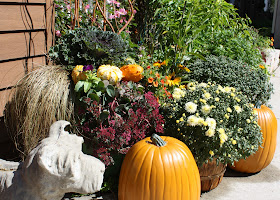I cut the Henryi Type 2 Clematis to the ground this year because it had become very woody. It has grown quite tall and is putting out one huge bloom to say goodbye.
Comtesse De Bouchard has lots to say as a type 3 if we don't get a frost. Look at all of those insect bites, many more than during the spring and summer.
Duchess of Albany is a type 3 saying goodbye with just one bloom. Again, it is being eaten by insects.
Miss Bateman type 2, you have come back, so nice of you to visit before going to sleep even if is only one bloom!
The Rhodies will develop some reddish colored leaves, not to worry, this is normal for this time of year. They will drop these leaves but will be perfectly healthy for new growth in the spring. Remember when it gets really cold or really hot their leaves curl under.
I am finding it difficult to say goodbye to my Pineapple Coleus (which has become more veined as the weather has cooled) and the Pink Knockout Rose. My rose has not made an appearance in two months, but it has come to say goodbye.
The tuberous begonias have done well all summer, I will certainly bring more of these into my garden next year.
The Volcano Phlox Pink with White Eye is blooming even after a traumatic hot summer planting.
This petunia has done nothing all summer, I have even forgotten its name, but now it is making a last hurrah!
The Italian parsley will hold up until November. It takes a really hard frost to take parsley out.
Ursula
Andrea orange mum and unnamed yellow cultivar
Unnamed yellow cultivar (I know I said I wasn't going to buy so many mums but I couldn't resist)
The pansies are beginning to fill out with the cabbages and red swiss chard.
Bright Lights Swiss Chard (the lights are the stems not the leaf)
Plumbago under the Arnie's Choice daylilies (this experiment worked in regard to having something that is growing under the daylilies after they are cut down in July)
Let's Dance is a new lace cap hydrangea that has suffered this summer with the heat. It is now putting forth many new buds. We'll see you next year!
The back border will soon be gone with the first frost. Goodbye!
I am concerned about saying hello to anything in the next few months. It has been so intensive during the spring and summer months, we need to figure out our discussions for those cold winter days!
I like Larry Conrad's idea about developing a forum for discussing what worked for us and what didn't and maybe coming up with some ideas for a better 2011.


















































